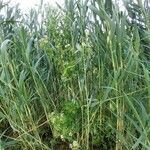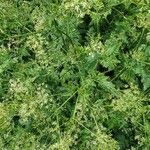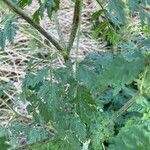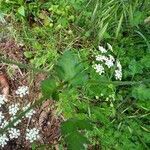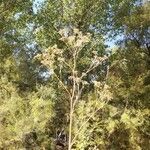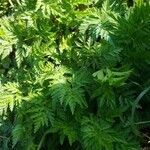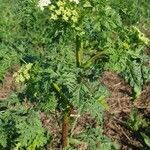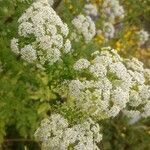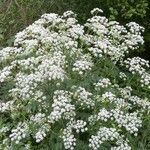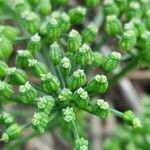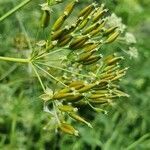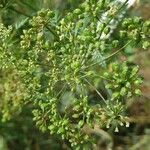Erect annual or biennial, with foetid odour when crushed. Stems hollow, striate, up to 2-(3) m high, usually light green and purple spotted or blotched, sometimes tinged purplish or pink, particularly toward base. Lvs 2-4-pinnate; ultimate segments narrowly or broadly ovate to deltoid, pinnatisect or serrate, 5-40 mm long; petioles light green and purple blotched when mature; stem lvs similar to basal, but shortly petiolate and 1-3-pinnate. Umbels 1-8 cm diam.; rays 4-16; bracts c. 4-8, narrow-triangular, acuminate, reflexed; bracteoles 3-6, triangular, confined to outer side of umbellets. Fls numerous, white, c. 2 mm diam. Fr. dark brown, 2.5-3 mm long; ribs slender, light brown, often crenulate.
Plants 80–200(–300) cm, essentially glabrous. Basal leaves on long-petioles, petioles 7–25 cm, sheaths small, narrow; blades 2–3-pinnate, 10–30 × 6–28 cm, finely divided; pinnae petiolulate; ultimate segments oblong or ovate-lanceolate, 1–3 × 0.5–1 cm, short-petiolulate, incised or pinnatifid. Leaves gradually reduced upwards. Umbels 4–7 cm across, lateral umbels overtopping the terminal; peduncles 2–7 cm; bracts 4–6, ovate-lanceolate, acuminate, 2–5 mm, reflexed; rays 10–20, 1.5–4 cm, unequal; bracteoles 5–6, ovate, 1.5–3 mm, fused at base; pedicels 10–20, 1–5 mm, unequal. Petals ca. 1.5 × 1 mm. Fruit 2–4 × 1.5–2.5 mm. Fl. and fr. May–Aug. n = 11.
A plant which usually grows over 2 years but can grow as an annual. It grows 2-2.5 m high. The stems are hollow. They are pale green with purple patches. The leaves at the base are in a ring. The leaves are pale green and large. They are divided twice. The segments are oblong or sword shaped. The edges have deep teeth. The leaf stalk sheaths the stem. The flowers have small white petals which curve inwards. The flowers are in a compound head. (The plant should not be confused with parsley nor the seeds with anise.) Both the fruit and leaves are poisonous.
Stem freely branched, to 3 m, purple-spotted; lvs 2–4 dm, broadly triangular-ovate, 3–4 times pinnately compound, the ultimate segments ovate-oblong, 4–10 mm, toothed or incised; umbels 4–6 cm wide, the terminal one blooming first but soon overtopped by others; fr broadly ovoid, 3 mm, the pale brown ribs very prominent when dry; 2n=22. Native of Eurasia, now widely intr. as a weed in waste places from Que. to Fla., w. to the Pacific. This is the hemlock of classical antiquity. All parts of the plant are very poisonous.
Terminal umbels on short peduncles, overtopped by the longer-peduncled laterals. Bracts and bracteoles well developed, lanceolate to broadly lanceolate, often with a whitish margin, somewhat caducous. Umbels with up to 20 rays 2–3·5 cm. long, partial umbels with 6–15 flowers on pedicels 2–5 mm. long.
Leaves up to 35 cm. long, 2–3-pinnate, broadly ovate to deltate in outline; ultimate segments lanceolate to elliptic, deeply and coarsely divided, apices of the lobes slightly mucronate; petioles up to 10 cm. long, dilated at the base to form a conspicuous sheath.
Fruit ovoid to suborbicular, somewhat laterally compressed; Stylopodium depressed; styles deflexed with somewhat swollen bases. Ribs well developed, either linear or very distinctly undulate; vittae 0; seed channelled on the inner face.
Stem with rather fine, regular grooving, often with irregular, characteristic purple spots, but sometimes unspotted especially in southern Africa.
Erect, glabrous biennial herb up to 2 m. with a somewhat fleshy taproot.
Like C. sphaerocarpum but stem speckled below and mericarps ribbed.
Calyx teeth obsolete; petals white with a short inflexed tip.
